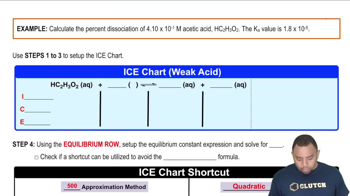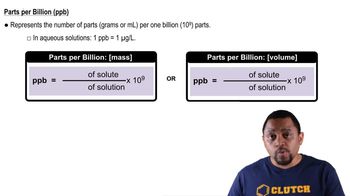Suppose you want to do a physiological experiment that calls for a pH 6.50 buffer. You find that the organism with which you are working is not sensitive to the weak acid H2A 1Ka1 = 2 * 10-2; Ka2 = 5.0 * 10-72 or its sodium salts. You have available a 1.0 M solution of this acid and a 1.0 M solution of NaOH. How much of the NaOH solution should be added to 1.0 L of the acid to give a buffer at pH 6.50? (Ignore any volume change.)
Ch.17 - Additional Aspects of Aqueous Equilibria
Chapter 17, Problem 97d
Lead(II) carbonate, PbCO3, is one of the components of the passivating layer that forms inside lead pipes. (d) The EPA threshold for acceptable levels of lead ions in water is 15 ppb. Does a saturated solution of lead(II) carbonate produce a solution that exceeds the EPA limit?
 Verified step by step guidance
Verified step by step guidance1
Step 1: Write the dissolution equation for lead(II) carbonate: PbCO_3(s) \rightleftharpoons Pb^{2+}(aq) + CO_3^{2-}(aq).
Step 2: Use the solubility product constant (K_{sp}) for PbCO_3 to express the equilibrium concentrations of the ions. The K_{sp} expression is K_{sp} = [Pb^{2+}][CO_3^{2-}].
Step 3: Assume the solubility of PbCO_3 is 's' mol/L. At equilibrium, [Pb^{2+}] = s and [CO_3^{2-}] = s. Substitute these into the K_{sp} expression to solve for 's'.
Step 4: Convert the solubility 's' from mol/L to ppb (parts per billion) for lead ions. Use the molar mass of lead to convert moles to grams, and then convert grams to ppb.
Step 5: Compare the calculated ppb of lead ions in the saturated solution to the EPA threshold of 15 ppb to determine if the solution exceeds the limit.

Verified video answer for a similar problem:
This video solution was recommended by our tutors as helpful for the problem above.
Video duration:
6mWas this helpful?
Key Concepts
Here are the essential concepts you must grasp in order to answer the question correctly.
Solubility Product Constant (Ksp)
The solubility product constant (Ksp) is a numerical value that represents the extent to which a compound can dissolve in water. For lead(II) carbonate, PbCO3, Ksp can be used to determine the concentration of lead ions in a saturated solution. If the concentration of lead ions exceeds the EPA limit of 15 ppb, the solution is considered unsafe.
Recommended video:
Guided course

Solubility Product Constant
Lead(II) Carbonate Dissociation
Lead(II) carbonate dissociates in water to produce lead ions (Pb²⁺) and carbonate ions (CO3²⁻). The equilibrium established during this dissociation is crucial for calculating the concentration of lead ions in a saturated solution. Understanding this dissociation helps in assessing whether the lead concentration surpasses regulatory limits.
Recommended video:
Guided course

Percent Dissociation Example
Parts Per Billion (ppb)
Parts per billion (ppb) is a unit of measurement used to express very dilute concentrations of substances. In the context of water quality, it indicates the number of parts of a substance per billion parts of water. The EPA's threshold of 15 ppb for lead ions is critical for determining the safety of drinking water, making it essential to compare the calculated lead concentration against this standard.
Recommended video:
Guided course

Parts per Billion (ppb)
Related Practice
Textbook Question
Textbook Question
For each pair of compounds, use Ksp values to determine which has the greater molar solubility: (a) CdS or CuS (b) PbCO3 or BaCrO4 (c) Ni(OH)2 or NiCO3 (d) AgI or Ag2SO4.
Textbook Question
The solubility of CaCO3 is pH dependent. (b) Use the Kb expression for the CO32- ion to determine the equilibrium constant for the reaction CaCO3(s) + H2O(l) ⇌ Ca2+(aq) + HCO3-(aq) + OH-(aq)
